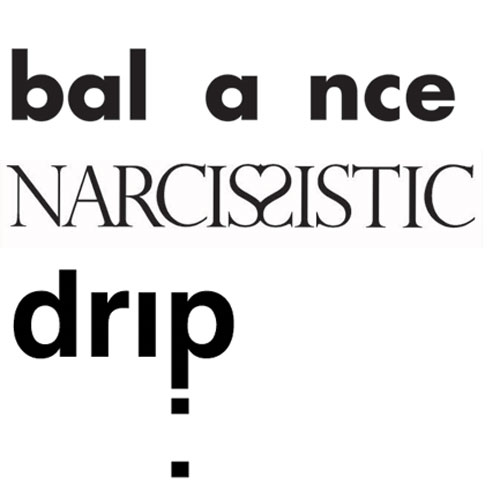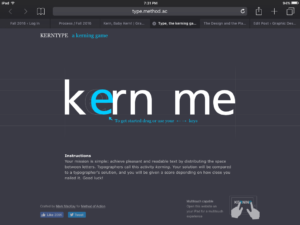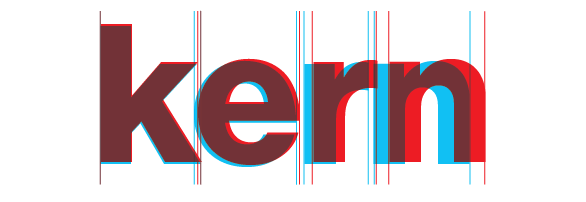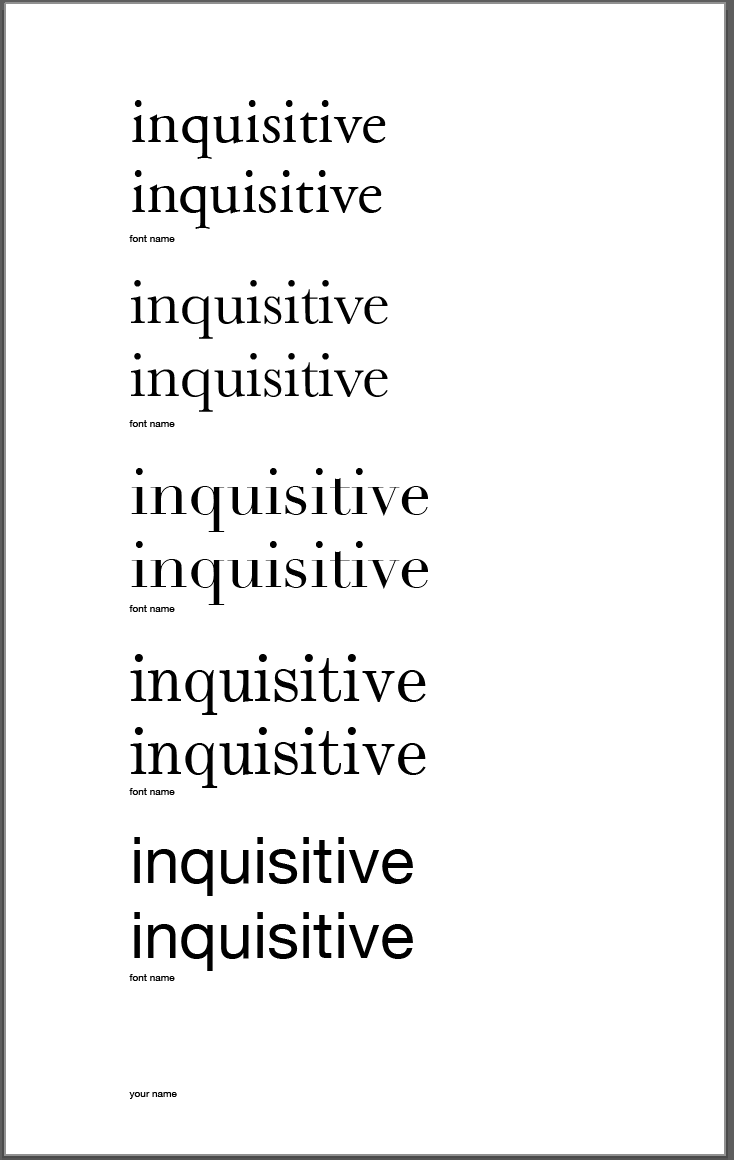Modify a series of 4 words, one per 6″x6″ page, to express their meaning typographically.
It is said that a picture is worth a thousand words, but can one word become a picture? Graphic designers are often called to create expressive designs using only typography. Designer Ellen Lupton once wrote that “Typography is what language looks like” and your objective is to express the meaning of language using only letterforms. Using the five classic typefaces you will begin with a simple word and make the minimum changes necessary to effectively communicate the word visually.

Reread
Please take another look at The Design and the Play by Paul Rand.
Look up your word
Before you do anything, you need to find out what these words really mean. Do not rely on your imperfect idea of what you think a word means.
- The Oxford English Dictionary: You will need to log in but this is the master dictionary of the English Language.
- Consult three different dictionaries. Read the word origins too.
- Look your word up in a variety of printed dictionaries as well. They have many at the library.
Create a Word Definition Post
Create a post called the name of your your words where you define the words for yourself in your own words based on your research. What did you learn about the word and its origin that you did not know already?
Use the category: “word definition”
Composition
Use the space of the frame dynamically. Create a layer that activates the tension between space and object. This usually means keeping the words smaller unless making them large is essential to the idea.
You are encouraged to place the words in different locations in the square. Where does the word communicate its idea the best? Use a variety of approaches to the designs. Do some words crop off the sides? Do all the letters fit into the space? Do letters want to overlap? Rotate? Flip? You will choose to change the position, scale and rotation of selected letters to express them.
Rules of the game
You MAY do the following:
- Rotate
- Scale proportionally
- Extend off the frame
- Repeat letters only when necessary…
You MAY NOT:
- Texture words
- Dont stretch
- Cut the letters
- Use other typefaces
- Change the opacity
- Use outlines (solid letters only)
Acceptable Typefaces
You may use any typeface you want for any of your words as long as it is one of these five. You may use only the regular/book font (not bold for instance).
- Garamond
- Baskerville
- Didot
- Century
- Helvetica
Be prepared to explain what typeface you used for which composition.
Your Words
You will work with 4 words:
- Two from my list on this page — assigned by lottery
- One from mind maps you create
- One from the Compendium of Lost Words
Create three different concepts (art boards) for each word for a total of 12 designs.
The Process
- Using Illustrator make a 6″x6″ file.
- Start your word in a selected typeface at 60 points.
- Place in the right place on the page in the correct typeface.
- Duplicate the artboard 2 times so you have the word + 2 copies.
- Change the typeface for each of the three artboards.
- Kern them all properly.
- Go to the the “Type” menu and select “Create Outlines” for each artboard.
- Ungroup the letters and begin working with them.
- Start with one change to communicate the word (scale, rotate, position). If you need more then try two changes (scale and rotate, or move two letters). Be conservative in the changes initially. Use only the graphic moves necessary to express the word.
- Activate the space in the composition to create a dynamic design.
- When you have expressed the word then move to the next artboard.
- Create more versions of each word than the required 3 designs to find the best solutions.
- Create at least three different concepts (artboards) for each of your four words for a total of 12 designs.
- Repeat steps 2-11 for additional three words.
1 / My List
Assigned by lottery
-
- fright
- angry
- impulsive
- isolation
- tension
- energize
- rhythm
- radiant
- sorrow
- uneasy
- caffeine
- conflict
- scattered
- wander
- clumsy
- cheerful
- alarmed
- whimsical
- haunted
- overjoyed
- magnetic
- explosive
- surprised
- discombobulate
- splash
- kerplunk
- sizzle
- hiccup
- delightful
- slurp
- gurgle
- creak
- rebellious
- disoriented
- intrude
- provoke
- eccentric
2 / Mind Maps
Do a mind map with a group of classmates using your assigned words on the list above as the ‘seed.’ Let your minds wander and fill the page with associations. Circle a dozen or so verbs or adjectives that have expressive potential for you. Talk to classmates and select a few words to try. Choose these words carefully. Try not to be too abstract. Is there something about those words that suggest visual solutions? Don’t be obvious such as the word ‘Fall’ (and it is only four letters).
Select one to express.
3 / Lost Words
Choose one ‘Lost Word’ from the Compendium of Lost Words and express its meaning. The class should be able to ascertain a general idea or feeling about the word from your design.
Format
6” x 6” trimmed precisely (you will be graded on the craft of cuts and precise measurement)
Color
Black and White Laser Print
Due Tuesday, February 21
All three versions of each of the 4 words printed and trimmed (12 total compositions) ready to hand in a manila envelope.
One PDF with all versions of the project uploaded to your dropbox folder. Must have at least 12 compositions (preferably more). Title them 04 Expressive Words_lastname.pdf






“oot” : meaning whoops or oh no. example, “OOT! I forgot about my essay due tomorrow”.
“hattitude” : a hateful attitude.
“nonversation” : small talk/ pointless conversation.
1.) “HANGRY” : (adj.) describing someone as hungry and miserable at the same time, usually making them very miserable.
I wish this was a word because I often find myself being both hungry and miserable, so a word describing the two would fit perfectly in my life.
2.) “AWKLENCE”: (noun) extreme awkward silence between two or more people, causing people to be uncomfortable.
I wish this was a word because often times in my life I find myself having awkward silence during a conversation with another person.
3.) “FOODMOTION”: (noun) the state of being in love with food, having strong emotions for food.
I wish this was a word because I love food so much and it plays a big part in my daily life.
“Geekin” : Laughing hard for an extensive period of time
This is a term my friends and I use a lot when one of us can’t stop laughing over something. I think this would be a useful word because I often find myself laughing longer than I should.
“Foodbaby”: The enlargement of the stomach after consuming lots of food
This is a term I have heard many people use after feeling full and I think it should be a word because it accurately describes how you feel after eating too much
“Carcolepsy”: A condition where the passenger in a vehicle falls asleep as soon as the vehicle starts moving.
I think this would be a useful word to describe me because I am someone who falls asleep in the car often.
“Caraoke” (verb) – to sing loudly and often badly while driving in a car
I always sing in the car even though I am not the best singer. I call it caraoke.
“Confuzzled” (verb) – to be confused
I’m not sure how this happened but my friends and I often say “I am confuzsled” instead of “I am confused.”
“Riboflabbin” (noun) – the fat attached to a peice of meet
I always take the fatty part of steak off and it’s much more fun to call it riboflabbin.
“Squoze”: Past tense to squeeze something or someone
I wish this was a word because it sounds like an actual word that’d you’d use after you gave someone a big hug.
“Hecka”: Slang for extremely or very
My friend uses this to describe something that he likes a lot or thinks in cool
“Merp”: Describing a feeling of awkwardness
I feel that in a conversation sometimes it can get uncomfortable and you feel this way
“D’Angeloed”: (adj.) When someone is intoxicated.
I wish it was a word because it means you are toasty and well off for the night.
“Bimple”: (noun) Back dimples.
I wish it was a word because its fun to say.
“Yish”: (adj.)
simply means yes
1. Dovorntle- When a book uses so much detail to describe something that you can no longer create an accurate image in your head of what you should be imagining.
Unfortunately, this happens often enough for me that it needs a word.
2. Shmwoop- The last bits of unwanted cereal, when they are too soggy to eat
This is a relevant, constantly occurring morning event for me and it needs a word.
3. Pinecha- The satisfying crunch made specifically by fallen pinecones when they are stepped on.
Who doesn’t love stepping on pinecones for the crunch? It needed its own word.
Cellfish- someone who is being inconsiderate and constantly sits on their phone when with others.
Many people are obsessed with their phones and never get off them. A way to describe this is being cellfish (cell phone/selfish)
Hangry- Being angry because you are hungry .
I use this word a lot and I think a lot of other people do as well. A lot of people tend to get very cranky when they haven’t eaten and this is a perfect word to describe that.
Hiberdating- When a person ignores their friends and or family after getting a boyfriend or girlfriend.
A lot of people get into relationships and then fall off the face of the earth for a while. Hiberdating explains this well since eventually they come back around again its like they were hibernating.
Hangry: when you are so hungry that your lack of food causes you to become angry, frustrated or both.
-I get angry when I’m hungry and sometimes my mom says I’m hangry.
Nonversation: a completely worthless conversation, wherein nothing is illuminated, explained or otherwise elaborated upon.
– I feel when you talk to someone you don’t know you make small talk and pointless conversations.
Foodbaby: when you eat so much, that your stomach looks pregnant.
– every time me or my friends eat too much we always say how we have a food baby.
Confuzzled- to be confused
Shmammered- to be very, very drunk
Betch- a more affectionate and equally sarcastic use of the word bitch
One word that I believe should be a word is confuzzled. Confuzzled is a word that means confused or puzzled, except the pronunciation is different and more fun to say. The second word i think shoud be a word is hungry. This word is a word to describe your mood when you are angry and hungry or when you are angry because you are hungry. This word should be a word because it is a common mood when someone is hungry. The third and final word that I think should be a word is meh. Meh is a word that is used to describe something that is just okay or average. This is a word that I use a lot for something that isn’t actually a word. It should be a word because it can be used to describe almost anything. A piece of food can be meh or your day can be meh. Whatever the use, it almost always works.
I don’t know how to delete a comment to fix it but I am aware of the lower case I that I put by accident in my post. I just missed it when reviewing it
“Textpectation” – the anticipation felt when waiting for a reply.
In our generation, this word is very relevant because most of the communication we experience is through text messages, direct messages, etc. It’s easy to know that most people have experienced the feeling of textpectation in this day and age.
“Dudevorce” – when two guys end a close friendship.
Bromance has always been a common phrase that people would use to describe two guys who have a very close friendship, so it only make sense that theres a word for when the bromance ends. I also just enjoy the word and how it sounds.
“Askhole” – someone who always asks questions that are perceived as dumb.
While were taught there are no dumb questions, theres always someone who asks the questions that you can’t help but judge. This word allows for a fun way to describe that person that we all know.
Refill-An inch of snow.
(The weather channel says theres going to be 5 refills today.)
Season- Time to do something
(It’s library season.)
(Are you gym season?)
Loose-When someone is acting extremely sloppy.
(Someone walking around in the winter time with only a t shirt and shorts on and only one shoe would be described as Loose.)
Yammed- When something is jammed into a tight space.
(The car was full but I was able to be yammed in)
Yam- To forcefully do something.
“Yam that food, we have class in 5”
Monday- Someone you can’t stand.
“Hitler was just another Monday”
Townie- A person who is a native of a certain town or city. Also called locals.
“The townies always know where the best fishing spots are”